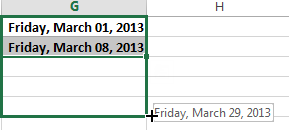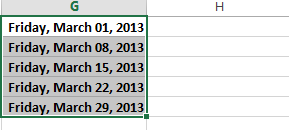Introduction
Whenever you work with Excel, you’ll enter information—or content—into cells. Cells are the basic building blocks of a worksheet.
Understanding cells
Every worksheet is made up of thousands of rectangles, which are called cells. A cell is the intersection of a row and a column. Columns are identified by letters (A, B, C), while rows are identified by numbers (1, 2, 3).

Each cell has its own name—or cell address—based on its column and row. In this example, the selected cell intersects column C and row 5, so the cell address is C5. The cell address will also appear in the Name box.
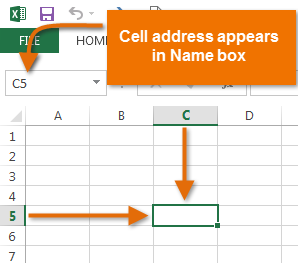
You can also select multiple cells at the same time. A group of cells is known as a cell range.
In the images below, two different cell ranges are selected:
- Cell range A1:A8
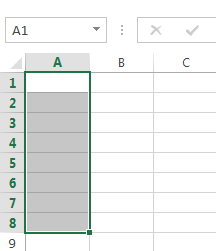
- Cell range A1:B8
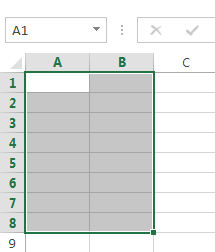
To select a cell:
To input or edit cell content, you’ll first need to select the cell.
- Click a cell to select it.
- A border
 will appear around the selected cell, and the column heading and row heading will be highlighted. The cell will remain selected until you click another cell in the worksheet.
will appear around the selected cell, and the column heading and row heading will be highlighted. The cell will remain selected until you click another cell in the worksheet.

You can also select cells using the arrow keys on your keyboard.
To select a cell range:
Sometimes you may want to select a larger group of cells, or a cell range.
- Click, hold, and drag the mouse until all of the adjoining cells you want to select are highlighted.
- Release the mouse to select the desired cell range. The cells will remain selected until you click another cell in the worksheet.
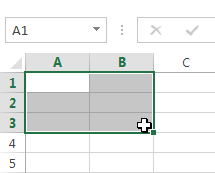
Cell content
Any information you enter into a spreadsheet will be stored in a cell. Each cell can contain different types of content, including text, formatting, formulas, and functions.
- Text
Cells can contain text, such as letters, numbers, and dates.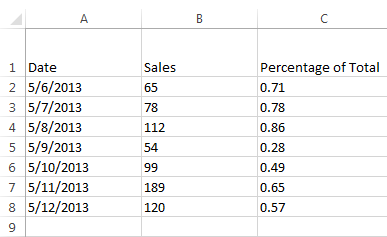
- Formatting attributes
Cells can contain formatting attributes that change the way letters, numbers, and dates are displayed. For example, percentages can appear as 0.15 or 15%. You can even change a cell’s background color.
- Formulas and functions
Cells can contain formulas and functions that calculate cell values. In our example, SUM(B2:B8) adds the value of each cell in cell range B2:B8 and displays the total in cell B9.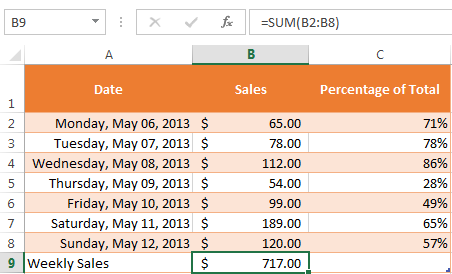
To insert content:
- Click a cell to select it.

- Type content into the selected cell, then press Enter on your keyboard. The content will appear in the celland the formula bar. You can also input and edit cell content in the formula bar.
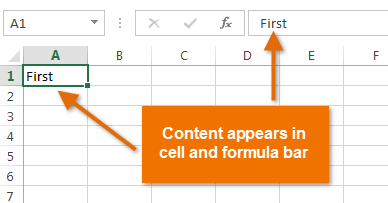
To delete cell content:
- Select the cell with content you want to delete.
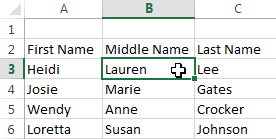
- Press the Delete or Backspace key on your keyboard. The cell’s contents will be deleted.
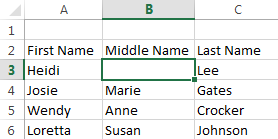
You can use the Delete key on your keyboard to delete content from multiple cells at once. The Backspace key will only delete one cell at a time.
To delete cells:
There is an important difference between deleting the content of a cell and deleting the cell itself. If you delete the entire cell, the cells below it will shift up and replace the deleted cells.
- Select the cell(s) you want to delete.
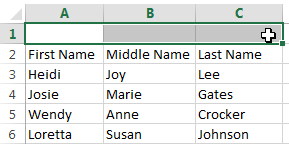
- Select the Delete command from the Home tab on the Ribbon.
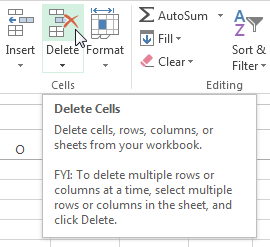
- The cells below will shift up.
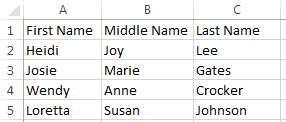
To copy and paste cell content:
Excel allows you to copy content that is already entered into your spreadsheet and paste that content to other cells, which can save you time and effort.
- Select the cell(s) you want to copy.

- Click the Copy command on the Home tab, or press Ctrl+C on your keyboard.
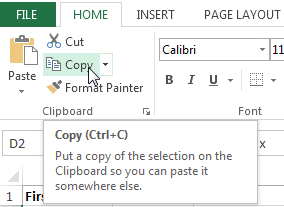
- Select the cell(s) where you want to paste the content. The copied cells will now have a dashed box around them.
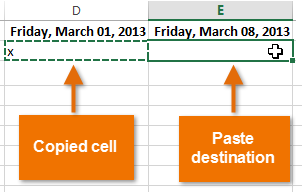
- Click the Paste command on the Home tab, or press Ctrl+V on your keyboard.
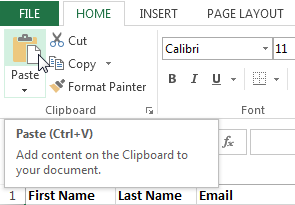
- The content will be pasted into the selected cells.

To cut and paste cell content:
Unlike copying and pasting, which duplicates cell content, cutting allows you to move content between cells.
- Select the cell(s) you want to cut.
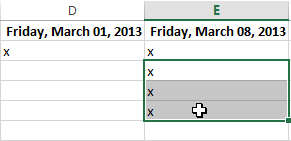
- Click the Cut command on the Home tab, or press Ctrl+X on your keyboard.
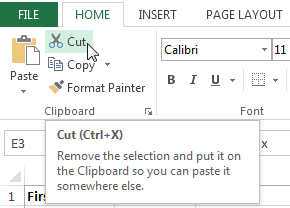
- Select the cells where you want to paste the content. The cut cells will now have a dashed box around them.
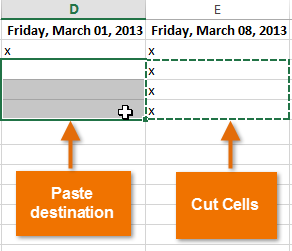
- Click the Paste command on the Home tab, or press Ctrl+V on your keyboard.

- The cut content will be removed from the original cells and pasted into the selected cells.
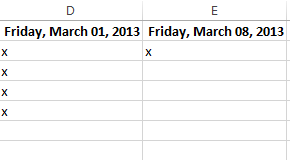
To drag and drop cells:
Rather than cutting, copying, and pasting, you can drag and drop cells to move their contents.
- Select the cell(s) you want to move.
- Hover the mouse over the border of the selected cell(s) until the cursor changes from a white cross
 to a black cross with four arrows
to a black cross with four arrows .
.
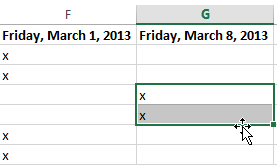
- Click, hold, and drag the cells to the desired location.
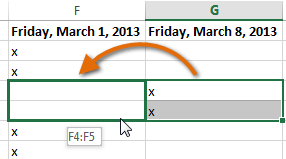
- Release the mouse, and the cells will be dropped in the selected location.
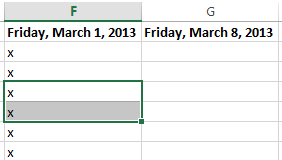
To use the fill handle:
There may be times when you need to copy the content of one cell to several other cells in your worksheet. You could copy and paste the content into each cell, but this method would be time consuming. Instead, you can use the fill handle to quickly copy and paste content to adjacent cells in the same row or column.
- Select the cell(s) containing the content you want to use. The fill handle will appear as a small square in the bottom-right corner of the selected cell(s).
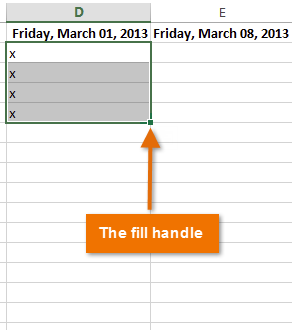
- Click, hold, and drag the fill handle until all of the cells you want to fill are selected.
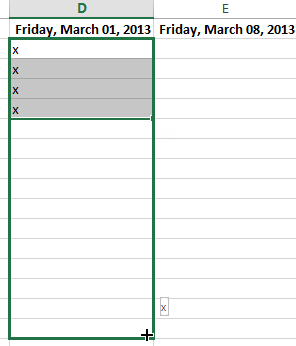
- Release the mouse to fill the selected cells.
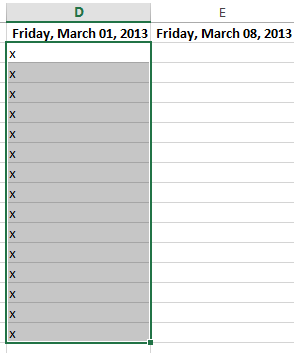
To continue a series with the fill handle:
The fill handle can also be used to continue a series. Whenever the content of a row or column follows a sequential order, like numbers (1, 2, 3) or days (Monday, Tuesday, Wednesday), the fill handle can guess what should come next in the series. In many cases, you may need to select multiple cells before using the fill handle to help Excel determine the series order. In our example below, the fill handle is used to extend a series of dates in a column.
